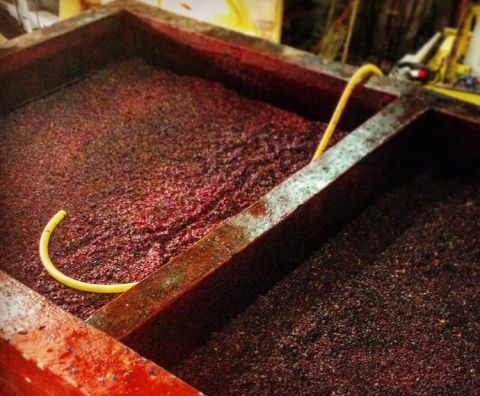Ayunta, Navigabile 2016/17 Etna

A pure, expressive and finely textured red from the north slopes of the volcano.
2016 from €23.95, $34.99, £29.50
2017 from €21.89, £25
I tasted Ayunta Navigabile 2017 Etna with Ayunta's Filippo Mangione (below) at the world’s first volcanic wine fair in the Auvergne at the end of January, and loved it for its freshness, purity of not-too-sweet fruit and fine, dry, chalky-textured tannins, a great example of a style I have come to associate with wines made from vines planted on volcanic soils (see Auvergne – quiet volcanoes and lively wines and Volcanic wines – fact or fiction?) and perhaps especially from Etna.
When I contacted Mangione this week, he assured me that the 2017 is available in Europe, the US, Australia and the UK even though most of the Wine-Searcher results are for the Ayunta Navigabile 2016 Etna. I loved his response when I asked how he was: ‘I'm isolated alone at the moment among my vineyards on Etna, struggling to make all the work in the fields by myself. It's very hard but I don't complain at all.’
Fortunately I have no trouble in recommending both vintages, having tasted the 2016 this week, just to be sure. The 2016 is certainly a little more developed, with more brick in its red colour, but it still has terrific fruit flavours and all those characteristics I found in the 2017 – perhaps more complex aromas and a little less pure precision. In both wines the fine, slightly chalky texture of the tannins is all tied up with the freshness and persistence of the wine.
You can read my full note on the 2016 and the 2017 in our tasting notes database. For what it’s worth, I scored the 2016 vintage 17 points (increasing it from 16.5 on the day after opening, because it just got better) and 17++ for the 2017 vintage to indicate that it had the potential to improve with a little longer in the bottle even though it is delicious now. Mangione tries to release his wines when they are ready to drink, not when the market calls for them. According to the label, the 2017 has slightly higher alcohol (14.5%) than the 2016 (13.5%) though it does not show in the wine.
Now in his early 40s, Mangione is from Agrigento on the south coast of Sicily, though he was born in Milan, growing up in both places. After some time working for other Italian wineries, selling wines in the US and around the world, 10 years ago he decided to start his own project ‘from scratch’.
He inherited no land from his family on Sicily and knew that Etna was the only place on the island he wanted to make wine: ‘Wines from Sicily, for me, meant from Etna, the place in my heart for the taste of the wine and for the rest of the magic.’
His first vintage was 2012, starting with one small parcel of vines on the north side of Etna, near Randazzo, from which he still makes the excellent single-vineyard wine Calderara Sottana, named after the contrada, or hamlet, in which he now lives in an old 1850s palmento (traditional Etna winery building – see Salvo Foti's explanation in this 2011 article of how a palmento can play a part in terroir).
He told me in an email, ‘I started everything from zero, focusing only on the best quality of grapes I could put together, organic farming and low-intervention in the winemaking process to develop the potential of the grapes and the purity of the taste of the terroir.’
The most remarkable thing about this wine is the vineyards it comes from: small parcels of old bush vines, some up to 150 years old, he believes, field blends of several varieties, red and white, with Nerello Mascalese as the dominant one. The dark- and light-skinned grapes are harvested separately. The soils are particularly varied because of the many different eruptions and subsequent weathering of the volcanic material.
‘The small old vineyards was the only choice I had', he explained. 'The biggest investors of the wine world were fighting to buy everything [see The great Etna landgrab – JR] but the small, old, low-yielding, family-run vineyards were not on their radar because they were useless for a high-scale project.
'But on a single-person-scale project, as was mine, they have been a terrific source for outstanding quality since the beginning. Of course also of dramatic work and high cost compared with the average of the yields, but the quality of the grape delivered from the old vineyards immediately let me make interesting wines with super low intervention in the cellar’.
Navigabile, by the way, means ‘able to be shipped by sail’ and historically indicated a merchant’s top wine, the one which would maintain its quality even after being transported long distances, which was much harder to achieve then than it is now thanks to better hygiene, packaging and informed use of SO2 as a preservative.
His interventions in the cellar are temperature control and light filtering. The wines are fermented with ambient yeasts in open vats and aged in big old barrels, both oak and chestnut for the 2016, to compare, and then only chestnut for the 2017. Just enough SO2 is added to protect the wine on its journey from the winery to the shelves, to make it ‘navigabile’.
I asked Mangione what difference he saw between the wine aged in oak and that in chestnut. He replied, ‘I have to say oak of course is more smart, sweet, perfectly balanced in the shaping of the wine, but chestnut looks to me to release some character of the wines more dark and intriguing, more bitter and iron-y I would say rather than sweet. And I like it! I like my Navigabile being more "hearty" and tasting a bit almost like blood and delivering that feeling of umami on the aftertaste that to me is quite cool and typical of the volcanic Nerello Mascalese from Etna.’
He now farms several different parcels of old vines comprising almost 6 ha (15 acres), at elevations of 600–1000 m (1,970–3,280 ft), making small volumes of six wines, with two more apparently on the way. The white Piante Sparse 2018 that I tasted at the volcanic wine fair, made from the white vines planted among the red in the old vineyards, shows Mangione’s skills are not limited to red wines.
Ayunta’s UK importer is Graft Wine Company and their Red Squirrel online shop is currently selling the 2016 vintage but the 2017 is already available from Bon Vino in Bermondsey, South London. The 2016 is also available from Vin Cognito and Winebuyers. According to Wine-Searcher, one or other of the two vintages can be found in Italy, the Netherlands and Canada (CA$269.17 per case of 6 of the 2017).
Ayunta have several importers in the US, who have kindly given me this additional information on stockists:
- Coeur Wine (NY): RRP for both vintages $32.50, available from Flatiron Wines, Manhattan Wine Company, Convive Wine & Spirits, UVA Wines and Spirit Animal – most will have moved on to the 2017 now, apparently
- Rinascimento Wine (CA): Solano Cellars ($33.75) and Wine House ($34.99) – currently selling the 2016 but will move on to 2017
- Ideal Wine & Spirits (MA): RRP $34 and currently holding stock of the 2016 (retailers taking previous vintages included Streetcar, Jamaica Plain; and Eataly Wine Shop, Boston)
- Sunrise Wines (NC): $42.25 Unwined on White wine lounge, Wake Forest; $35 Firefly, Greenville
Become a member to view this article and thousands more!
- 15,408 featured articles
- 275,020 wine reviews
- Maps from The World Atlas of Wine, 8th edition (RRP £50)
- The Oxford Companion to Wine, 5th edition (RRP £50)
- Members’ forum
- 15,408 featured articles
- 275,020 wine reviews
- Maps from The World Atlas of Wine, 8th edition (RRP £50)
- The Oxford Companion to Wine, 5th edition (RRP £50)
- Members’ forum
- 48-hour preview of all scheduled articles
- Commercial use of our wine reviews





